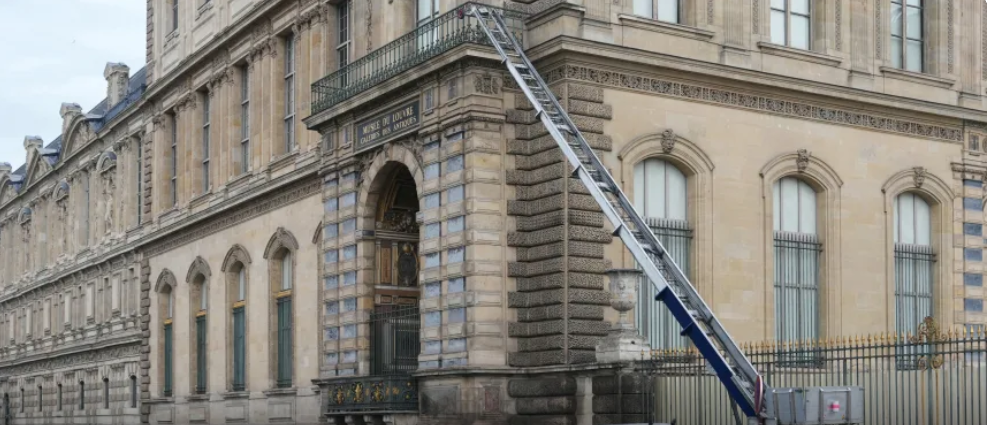Paris Police Arrest Suspects in Daring Louvre Jewel Heist

French police arrest two suspects linked to the brazen daylight theft of France’s crown jewels from the Louvre Museum. Here’s how investigators tracked them down before one fled the country.
The Aftermath of a Daring Heist
A week after one of the boldest museum robberies in recent French history, authorities in Paris have arrested two suspects believed to be connected to the theft of France’s crown jewels from the Louvre Museum’s Apollo Gallery.
The arrests mark a major breakthrough in a case that has shocked France and captured international attention.
The Paris prosecutor’s office confirmed that both men were detained over the weekend after an intense, week-long manhunt involving more than 100 investigators.
A Global Chase Ends at the Airport
According to prosecutors, one of the suspects was captured just moments before attempting to flee the country.
He was detained at Charles de Gaulle Airport (Roissy) during a routine passport check, allegedly preparing to board an evening flight to Algeria.
“The arrest took place as the suspect was about to leave French territory,” said Paris prosecutor Laure Beccuau.
The second man was arrested in Aubervilliers, a northern suburb of Paris long known as a hub for stolen-goods trafficking.
Both suspects are in their thirties and already known to police for previous offenses, French media reported.
DNA Evidence Cracks the Case
Investigators reportedly identified the pair through DNA traces recovered from the crime scene and the abandoned truck used during the heist.
Forensic teams matched samples found on discarded tools and gloves to existing profiles in the national database, providing a breakthrough that allowed authorities to zero in on the suspects.
BFMTV, which first reported the arrests, said that two additional accomplices remain at large.
Authorities believe they may have fled Paris in the days following the robbery, possibly taking the stolen jewels with them.
The Heist That Stunned France
The arrests come exactly one week after four masked men pulled off what officials are calling a “seven-minute heist.”
On a quiet Sunday morning, the thieves used a truck-mounted ladder to scale the façade of the Louvre and enter through a second-floor window leading to the Apollo Gallery, home to France’s crown jewels and other priceless artifacts.
Once inside, they smashed two reinforced display cases and seized nine items of Napoleonic-era jewelry — including a diamond-studded sapphire tiara and necklace once worn by Queen Marie-Amélie and Queen Hortense.
Security footage later revealed the group’s precision: they wore reflective safety vests to appear as maintenance workers and left the scene within minutes, disappearing into Paris traffic before police could respond.
Worth Over €88 Million
According to officials, the stolen collection is valued at €88 million (approximately $102 million USD).
However, experts say the true loss lies in the cultural and historical significance of the jewels — symbols of France’s royal heritage and craftsmanship.
“These are not just jewels,” said Laurence des Cars, director of the Louvre.
“They are living pieces of French history. Their disappearance is a terrible failure for us all.”
The Apollo Gallery, one of the most ornate rooms in the museum, was immediately closed to the public following the theft as investigators combed the area for clues.
A Coordinated, Professional Operation
From the outset, investigators described the robbery as the work of “a highly organized and experienced criminal team.”
The operation required technical precision, knowledge of museum security systems, and perfect timing.
Forensic analysts found evidence that the thieves used industrial-grade tools — including an angle grinder and thermal cutter — to break through security glass designed to withstand heavy impact.
“This was not an improvised job,” said a law-enforcement source familiar with the investigation. “They knew exactly where to go, what to take, and how much time they had.”
Inside the Investigation
Over the past week, detectives from the Brigade de Répression du Banditisme (BRB) — France’s elite organized-crime unit — have worked around the clock, following leads across Paris and neighboring regions.
Police reviewed hundreds of hours of CCTV footage from nearby streets, toll roads, and metro stations, while forensic specialists analyzed the abandoned truck left near the museum.
That vehicle, a white utility model equipped with a hydraulic lift, proved crucial to the investigation.
Inside, investigators discovered discarded gloves, a power grinder, and fingerprints that eventually led to the identification of the suspects.
Political Pressure and Public Outcry
The Louvre heist quickly became a national embarrassment.
Public anger grew as officials revealed that the thieves had entered the museum in broad daylight without triggering an immediate response.
France’s Justice Minister Gérald Darmanin publicly admitted that the robbery exposed serious security failings at the country’s most famous cultural institution.
“One can wonder why the windows weren’t secured, or how a basket lift could be parked right outside without alerting anyone,” Darmanin said in an interview with France Inter radio.
“What is certain is that we have failed.”
Museum director Laurence des Cars called the incident “a terrible failure,” promising sweeping internal reforms to prevent future breaches.
Interior Minister Praises Investigators
Following the arrests, France’s Interior Minister Laurent Nuñez praised the relentless work of the investigative teams.
“I want to commend the dedication of our officers,” he said. “They have worked tirelessly, as I asked them to, and they have always had my full confidence.”
Nuñez confirmed that investigators are still pursuing additional suspects and working to locate the missing jewels. “We will not rest until every individual responsible is brought to justice and every piece of France’s heritage is recovered,” he added.
The Hunt for the Missing Jewels
Despite the arrests, authorities have yet to recover any of the stolen jewelry.
Investigators fear that the items may already be in the hands of international smuggling networks, where they could be dismantled or melted down to disguise their origins.
Interpol has issued alerts to law-enforcement agencies across Europe and North Africa, warning jewel dealers and collectors to be on the lookout for rare 19th-century French pieces.
Experts note that the gemstones are difficult to sell intact due to their notoriety. “Anyone who tries to move these items will face enormous risk,” said Jean-Luc Moreau, an art-crime specialist based in Lyon.
“But breaking them down destroys their historical value. It’s a tragedy either way.”
Public Reaction: Shock and Relief
News of the arrests has sparked both relief and frustration among Parisians.
Outside the Louvre, visitors expressed gratitude that police had acted swiftly — but also disbelief that such a high-profile theft could occur in the first place.
“It’s good they caught them,” said tourist Élodie Martin. “But how could this even happen at the Louvre? It’s supposed to be one of the safest places in the world.”
Art historians and museum directors across Europe echoed similar sentiments, calling for tighter coordination between cultural institutions and law-enforcement agencies.
How the Louvre Plans to Recover
The Louvre Museum has since announced a comprehensive review of its security protocols.
New surveillance measures, reinforced glass display cases, and restricted access zones are being implemented.
Officials also plan to install motion-sensing alarms and increase guard patrols during early morning hours, when the museum is least crowded.
“The Louvre is not just a museum; it’s a symbol of civilization,” said des Cars.
“We owe it to our visitors, and to history itself, to ensure that something like this never happens again.”
A Reminder of History
This heist has drawn inevitable comparisons to the 1911 theft of the Mona Lisa, another episode that once stunned the world.
Just like then, investigators are racing against time to retrieve irreplaceable treasures before they vanish into the criminal underworld.
Over a century ago, the Mona Lisa was recovered two years after its disappearance. Authorities hope that the same determination — and a bit of luck — will help them recover France’s crown jewels as well.
The Road Ahead for Investigators
The next stage of the investigation will focus on tracing the jewels’ movement after the heist.
Authorities are examining financial transactions, phone records, and surveillance footage from jewelry markets across Europe.
Meanwhile, forensic analysts continue to search the suspects’ homes and vehicles for hidden caches or evidence of accomplices.
“The arrests are an important step, but not the end,” said prosecutor Beccuau.
“Our goal is to find the missing artifacts and bring every participant in this criminal network to justice.”
A Wake-Up Call for Cultural Security
Security experts say the Louvre heist serves as a warning for museums worldwide.
“Even with advanced technology, human vigilance remains key,” said security consultant Pierre Lemoine, who advises European art galleries.
“Museums need continuous audits, not just alarms and cameras. Organized crime adapts — so must we.”
The French government is now considering new funding for national heritage protection, including rapid-response teams trained specifically for cultural thefts.
A Case That Will Be Remembered
For France, the arrests offer a glimmer of hope in a case that had threatened to become a lasting national humiliation.
But until the jewels are found and restored to their rightful place in the Apollo Gallery, the story remains unfinished.
As Paris awaits the next development, one thing is clear: the theft of the Louvre’s crown jewels will go down as one of the most audacious crimes of the century — and the investigation as one of France’s most determined pursuits of justice.
Internal Linking Suggestions:
- Link “Louvre Museum heist” to your World News / Crime & Justice section.
- Link “France’s crown jewels” to your History & Culture category.
- Link “Apollo Gallery” to your Travel & Heritage Destinations page.
- Link “art-crime investigation” to your Global Security / Law Enforcement page






